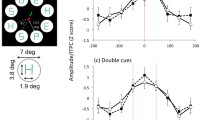Abstract
Visual attention tends to avoid locations where previous visual attention has once focused. This phenomenon is called inhibition of return (IOR), and is known as one of the important dynamic properties of visual attention. Recently, several studies have reported that IOR occurs not only on locations, but also on visual features. In this study, we propose a visual attention model that involves a featurebased IOR by extending a recent model of the “saliency map.” Our model is demonstrated by a computer simulation, and its neuronal basis is also discussed.
Similar content being viewed by others
References
Itti L, Koch C, Neibur E (1998) A model of saliency-based visual attention for rapid scene analysis. IEEE Trans Pattern Anal Mach Intell 20:1254–1259
Posner MI, Cohen Y (1984) Components of visual orientating. Attention Performance 10:531–556
Shin E, Wan XI, Fabiani M, et al (2008) Electrophysiological evidence of feature-based inhibition of focused attention across consecutive trials. Psychophysiology 45:804–811
Goolsby BA, Grabowecky M, Suzuki S (2005) Adaptive modulation of color salience contingent upon global form coding and task relevance. Vision Res 45:901–930
Knierim JJ, Van Essen DC (1992) Neuronal responses to static texture patterns in area V1 of the alert macaque monkey. J Neurophysiol 67:961–980
Schein SJ, Desimone R (1990) Spectral properties of V4 neurons in the macaque. J Neurosci 10:3369–3389
Treisman AM, Gerade G (1980) A feature-integration theory of attention. Cognitive Psychol 12:97–136
Koch C, Ullman S (1985) Shifts in selective visual attention: towards the underlying neural circuit. Hum Neurobiol 4:219–227
Lamme VA (1995) The neurophysiology of figure-ground segregation in primary visual cortex. J Neurosci 15:1605–1615
Gottlieb JP, Kusunoki M, Goldberg ME (1998) The representation of visual salience in the monkey parietal cortex. Nature 391:481–484
Schall JD, Hanes DP, Thompsons KG, et al (1995) Saccade target selection in frontal eye field of macaque. I. Visual and premovement activation. J Neurosci 15:6905–6918
McPeek RM, Keller EL (2002) Saccade target selection in the superior colliculus during a visual search task. J Neurophysiol 88:2019–2034
Lund JS, Lund RD, Hendrickson AE, et al (1975) The origin of efferent pathways from the primary visual cortex, area 17, of the macaque monkey as shown by retrograde transport of horseradish peroxidase. J Comp Neurol 164:287–304
Author information
Authors and Affiliations
Corresponding author
Additional information
This work was presented in part at the 15th International Symposium on Artificial Life and Robotics, Oita, Japan, February 4–6, 2010
About this article
Cite this article
Hotta, S., Oba, S. & Ishii, S. Visual attention model involving feature-based inhibition of return. Artif Life Robotics 15, 129–132 (2010). https://doi.org/10.1007/s10015-010-0778-7
Received:
Accepted:
Published:
Issue Date:
DOI: https://doi.org/10.1007/s10015-010-0778-7




